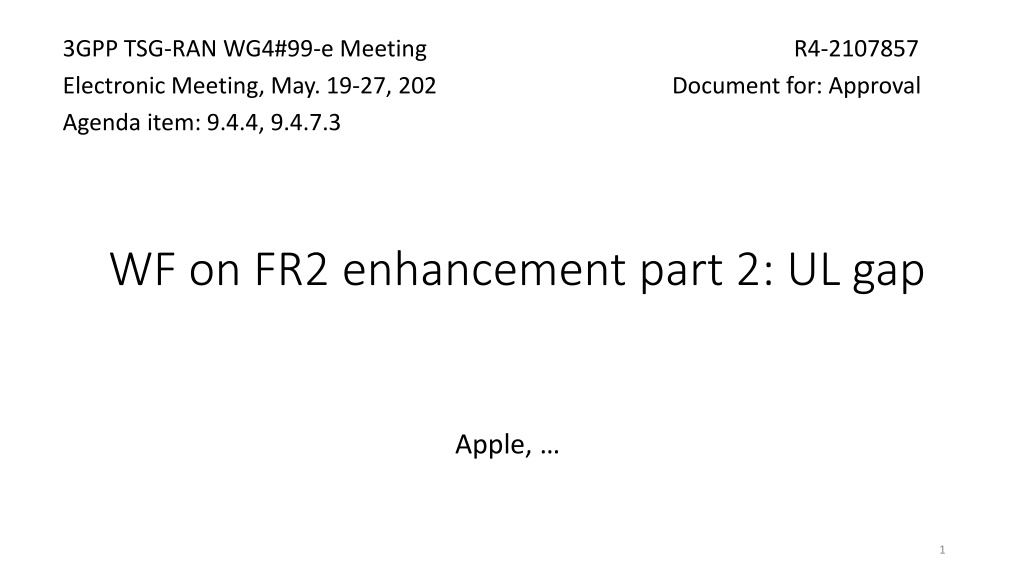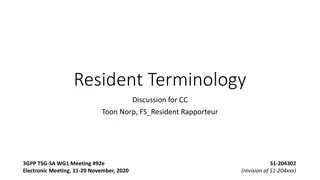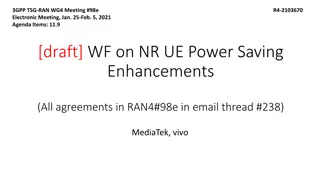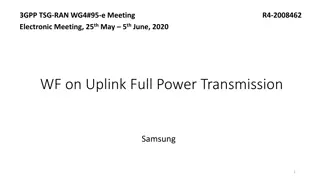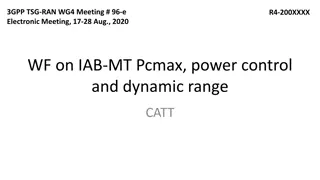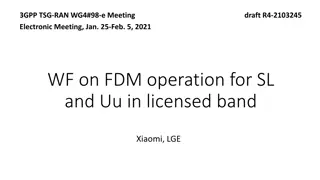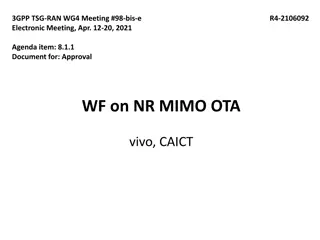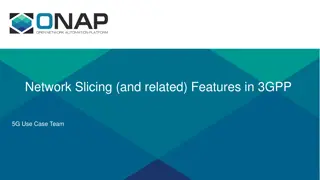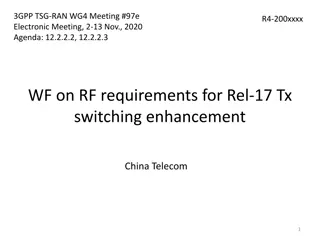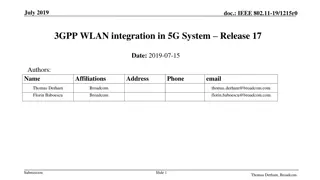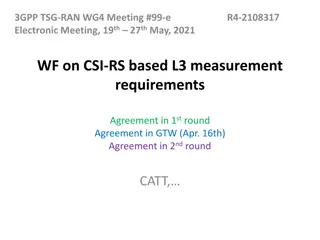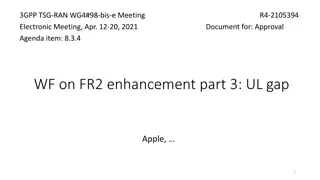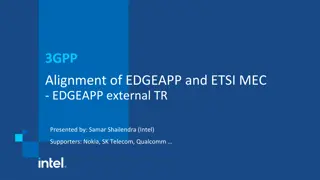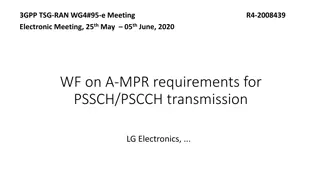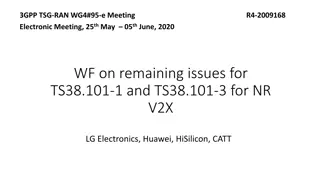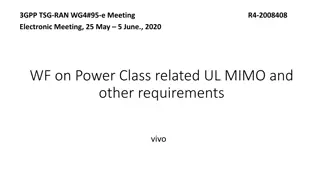Evolution of UL Tx Power Management in 3GPP Standards
The document discusses enhancements in UL Tx power management for FR2 spectrum bands, focusing on gap calibration prioritization, P-MPR reporting for BPS-based management, and RRM aspects of UL gap configurations. The agreements and decisions made by RAN4 are outlined, along with considerations for phantom simplification, legacy requirements, and MIMO technologies.
Download Presentation

Please find below an Image/Link to download the presentation.
The content on the website is provided AS IS for your information and personal use only. It may not be sold, licensed, or shared on other websites without obtaining consent from the author.If you encounter any issues during the download, it is possible that the publisher has removed the file from their server.
You are allowed to download the files provided on this website for personal or commercial use, subject to the condition that they are used lawfully. All files are the property of their respective owners.
The content on the website is provided AS IS for your information and personal use only. It may not be sold, licensed, or shared on other websites without obtaining consent from the author.
E N D
Presentation Transcript
3GPP TSG-RAN WG4#99-e Meeting R4-2107857 Electronic Meeting, May. 19-27, 202 Document for: Approval Agenda item: 9.4.4, 9.4.7.3 WF on FR2 enhancement part 2: UL gap Apple, 1
Way forward General issue Agreements: Subject to RAN plenary decision, RAN4 agrees to revise WID scope by deprioritizing gaps for PA calibration Subject to RAN plenary decision, RAN4 agrees to revise WID scope by deprioritizing gaps for TRX calibration Further discussion: Whether revise WID scope by deprioritizing gaps for TRX calibration 2
Way forward Tx power management: RF aspect Agreements: It is feasible to enable non-zero P-MPR in Tx power management and BPS related UL gap testing. zero P-MPR assumption for the existing test cases keeps unchanged On the test setups for UL gap based Tx power management. Option 1: Based on P-MPR report with/without blocking Option 2: Based on peak EIRP measurement with/without blocking Option 3: other method like jamming On mandating P-MPR reporting for the UE who is configured with UL gap for BPS based Tx power management. Option 1: Yes (Qualcomm, Nokia, Sony, Verizon, Apple, Samsung, Intel) Option 2: No. It is optional (OPPO, Huawei, Hisilicon) Option 3: depending on the conclusion of test case setup (Ericsson, vivo, AT&T) the baseline assumption is UE who is configured with UL gap for BPS based Tx power management is mandated for P-MPR reporting. The eventual decision should be also dependent on the requirements and test. On phantom or blocking be introduced in UL gap testing. Possible agreement: Continue discussion the test setup and requirement with and without phantom or blocking until RAN4 101e. Discuss phantom simplification, e.g., size, material and position On the RF requirement for the UE who is configured with UL gap for BPS based Tx power management Exact RF requirement will be based on test set up. The interested companies are encouraged to provide more details in next meeting, including the side conditions where 6dB or other values can be specified, including the assumptions of UL duty cycle, UL gap overhead/configurations, peak EIRP, etc. On legacy requirements and test for the UE configured with BPS gap It has been agreed in the past meetings that UE configured with BPS gaps is subject to fulfill all existing RF requirements. It is FFS to introduce the related test cases and if UE configured with BPS gap can skip the test without gap activated if it can pass the same test with gap activated. 3
Way forward Tx power management: RRM aspect Agreements: The baseline assumption for UL gap related configurations: UL gap is configured by NW via RRC signaling. Once UL gap is configured, it can be additionally activated or deactivated. It is up to network decision on whether to configure UL gap or not. It is FFS that the configured UL gap(s) can be activated/deactivated via MAC CE and/or DCI Gap configuration candidates: Candidates for gap periodicity: 5ms, 10ms, 20ms, 40ms, 80ms, 160ms, 320ms Candidates for gap duration: 62.5us, 125us, 250us, 500us, 1000us, Implicit activation to minimizing signaling, e.g., depending on PHR report. 4
Way forward Coherent UL MIMO Agreement: UL gap for coherent UL MIMO is within the scope of WI for FR2 enhancement. We should follow the previous agreement for the further discussion in phase I. Performance gain of coherent MIMO with calibration versus different gap overhead. NW impacts with respect to gap type (e.g. type 1 or 2) and the codebook assumption alignment between UE and NW 5
Contributions List in RAN4#98-e T-doc No. Title Company UL Gap testability and configuration aspects Qualcomm Incorporated R4-2108797 UL gaps for Tx power management RF aspect Apple R4-2109341 UL gaps for Tx power management RRM aspect Apple R4-2109363 Discussion on gap for PMPR calibration vivo R4-2109657 Network impact of UE FR2 UL Gap for UE Tx power enhancement Nokia, Nokia Shanghai Bell R4-2109744 Requirements and test cases of for P-MPR/EIRP enhancements for UE FR2 UL Gap Nokia, Nokia Shanghai Bell R4-2109745 Discussion on UL gap for self-calibration and monitoring ZTE Corporation R4-2109762 FR2 UL gap for power management (P-MPR) and Tx calibration (peak EIRP) NTT DOCOMO INC. R4-2110033 R17 FR2 UL gap for coherent UL MIMO OPPO R4-2110826 R17 FR2 UL gap for power management OPPO R4-2110827 Further consideration on UL calibration gaps Ericsson R4-2111151 Discussion on RRM impacts of UL gaps for self-calibration and monitoring vivo R4-2111260 On FR2 UL gap for coherence calibration Huawei, HiSilicon R4-2111383 6
Reference [1] R4-2107664, Email discussion summary for [99-e][138] NR_RF_FR2_req_enh2_Part_2 , Apple 7
